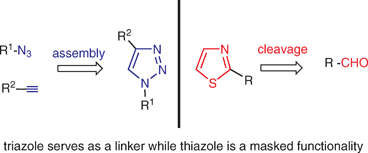Heterocycles in organic synthesis: thiazoles and triazoles as exemplar cases of synthetic auxiliaries
Abstract
This Perspective article illustrates the key role of

* Corresponding authors
a
Dipartimento di Chimica, Laboratorio di Chimica Organica, Università di Ferrara, Via L. Borsari 46, Italy
E-mail:
adn@unife.it
Fax: +39 0532 240709
Tel: +39 0532 455176
This Perspective article illustrates the key role of

 Please wait while we load your content...
Something went wrong. Try again?
Please wait while we load your content...
Something went wrong. Try again?
A. Dondoni, Org. Biomol. Chem., 2010, 8, 3366 DOI: 10.1039/C002586K
To request permission to reproduce material from this article, please go to the Copyright Clearance Center request page.
If you are an author contributing to an RSC publication, you do not need to request permission provided correct acknowledgement is given.
If you are the author of this article, you do not need to request permission to reproduce figures and diagrams provided correct acknowledgement is given. If you want to reproduce the whole article in a third-party publication (excluding your thesis/dissertation for which permission is not required) please go to the Copyright Clearance Center request page.
Read more about how to correctly acknowledge RSC content.
 Fetching data from CrossRef.
Fetching data from CrossRef.
This may take some time to load.
Loading related content
